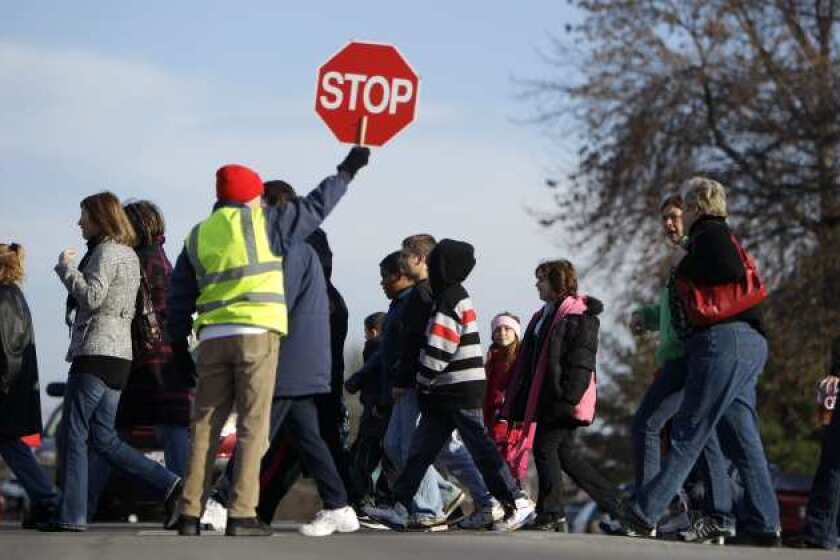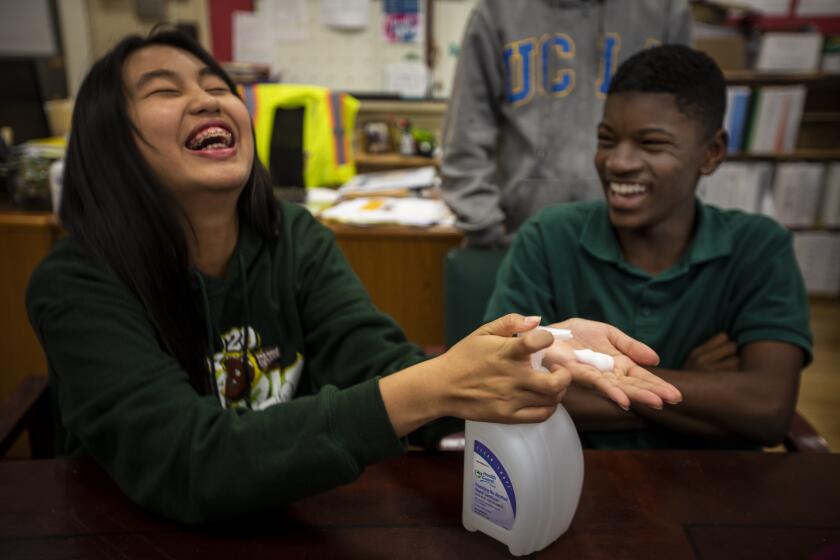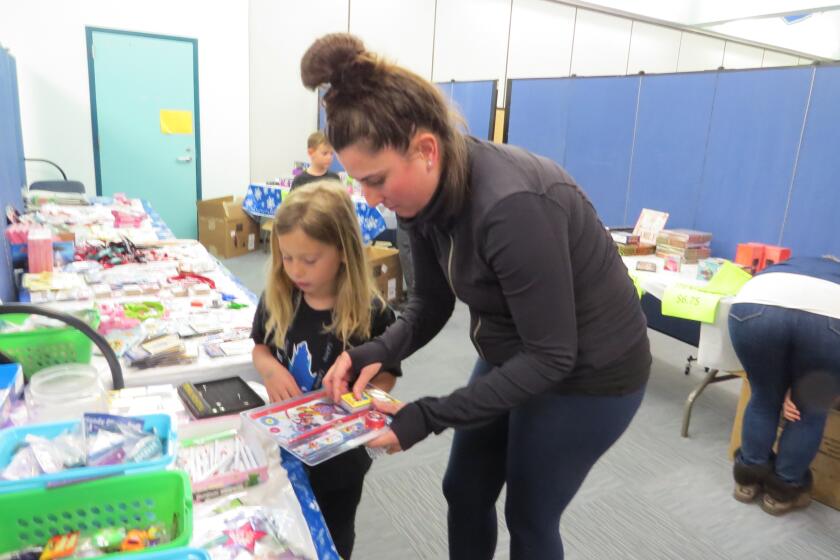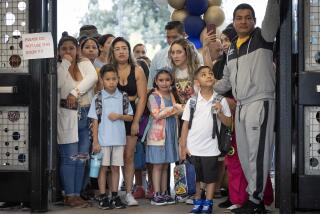‘This will be their 9/11’: How to help kids cope with coronavirus stay-at-home orders

- Share via
With stay-at-home orders enacted in California and schools likely closed for the rest of the academic year, children can be especially vulnerable as the security of their routines is upended and they worry about the health of loved ones.
“I think about our children who are growing up part of a generation — this will be their 9/11,” Los Angeles Mayor Eric Garcetti said in a news conference Thursday. “We have to explain this to them. We have to safeguard them. We have to hold them. I call it generation C, this generation that’s out there right now looking and feeling and wondering: Mom, Dad, whoever takes care of them, ‘What is this all about?’ And we need to step up for them.”
Here is advice from experts on how to help children understand what’s happening and cope with the changes around them:
Combating loneliness amid social distancing
It’s too early to say whether the novel coronavirus is the defining mental health event of a generation, said Dr. Roya Ijadi-Maghsoodi, a child psychiatrist and UCLA assistant professor. But many kids right now can’t run up and hug their grandparents, or see their friends and teachers at school every day. That could take an emotional toll.
“Even my 2-year-old — she’s been asking to see her grandparents,” Ijadi-Maghsoodi said. Instead of in-person meetings with older or more vulnerable people, schedule video calls where loved ones can read a story to a child, or your kid can show off what they’ve been working on.
Older kids may be used to connecting with their friends online, but “this is new for the younger ones,” Ijadi-Maghsoodi said. “The kids will follow the parents’ lead too. So if the child is missing somebody, you can talk about that and recognize that,” then think of ways to address it together.
That can mean setting up Facetime dates, phone calls, talking about the other kids they’re friends with, looking at pictures, or drawing something to send their friend, she said.
“Kids are going to miss their friends and their teachers — but kids are also really resilient, so I think we do have to go with this change and try to think of ways to help them feel connected,” IJadi-Maghsoodi said.
Validate children’s feelings by acknowledging that it’s hard not to see their grandparents or other loved ones, but parents can explain in an age-appropriate way that we’re taking these measures so that people don’t get sick. While we are not sure how long this will last, it is temporary.
“We are social beings so we do need hugs and touch but we’re doing pretend hugs, they can help you write letters,” Ijadi-Maghsoodi said. And you can make sure your kids know that they can still be close to you, she said.
As school districts close over COVID-19 concerns, how are the closures affecting you, your family or your community? We want to hear from you.
Does learning even matter right now?
Yes, for a few reasons. First of all, routines are helpful to kids during uncertain times, Ijadi-Maghsoodi said. And usually their routine is to go to school and learn, so maintaining a sense of normalcy will help kids feel safer too. It also provides a distraction for children, Ijadi-Maghsoodi said, although she wouldn’t phrase it that way to children.
“Framing it in terms of a schedule ... we’re all working on our new schedules right now” is helpful, she said. That can mean implementing a school routine, like working on the packets for a few hours in the morning, then a lunch break.
But parents, please — go easy on yourself, Ijadi-Maghsoodi said.
“I do hope that parents aren’t putting too much pressure on themselves right now,” Ijadi-Maghsoodi said. “We all have to do the best we can and sometimes that means making sure kids are being fed that day” and setting aside a little time for schoolwork.
Having kids at home during the coronavirus pandemic is a challenge for parents. Here are some resources to help get you through the day.
How to talk about money problems
This is a time of economic uncertainty for many families. Parents need to be honest with children without causing alarm.
“Kids can make up more scenarios if we’re not telling them” the truth, Ijadi-Maghsoodi said. If you lost your job or have to cut back on expenses, you can explain that to kids depending on their age — adolescents and teens may understand and need to know, while parents should not overly burden younger children with financial worries.
“You can say — there’s been a lot of changes and I know you’re worried, and we are going to keep talking about it as a family and find ways that we can make it through this,” she said. It may also be helpful to tell them that there are adults in the government working on solutions for families who are in this situation.
Also emphasize that “we may not be able to do all the things we were able to do before ... but we’re here to take care of you,” she said.
If you’re in a tight space physically with family and children, acknowledge that might be hard, Ijadi-Maghsoodi said. As a family, think about ways to ask for and make space , she said — there could be a corner of the living room that’s for the kids when they need it. And families can still go on walks, so take advantage of the L.A. weather and go outside while staying away from others.
What do I say to kids asking about coronavirus?
The National Assn. of School Psychologists and the National Assn. of School Nurses put out detailed guidelines for parents in late February explaining that when it comes to talking to kids about a pandemic, it’s best to reassure them while also providing “factual, age-appropriate information about the potential seriousness of disease risk and concrete instruction about how to avoid infections and spread of disease.”
For younger children, the guide says, it’s best to give “brief, simple information that should balance COVID-19 facts with appropriate reassurances.”
“Give simple examples of the steps people take every day to stop germs and stay healthy, such as washing hands. Use language such as ‘adults are working hard to keep you safe,’” the guide says.
Older children, meanwhile, are “able to discuss the issue in a more in-depth (adult-like) fashion and can be referred directly to appropriate sources of COVID-19 facts. Provide honest, accurate and factual information about the current status of COVID-19. Having such knowledge can help them feel a sense of control,” the guide says.
The Centers for Disease Control and Prevention has also offered a list of guidelines for talking to kids about coronavirus. They include:
- Remain calm and reassuring.
- Make yourself available to listen and to talk.
- Remember that viruses can make anyone sick, regardless of a person’s race or ethnicity.
- Pay attention to what children see or hear on television, radio or online.
- Consider reducing the amount of screen time focused on COVID-19 and provide information that is honest and accurate.
- Give children information that is truthful and appropriate for the age and developmental level of the child.
- Talk to children about how some stories on COVID-19 on the internet and social media may be based on rumors and inaccurate information.
- Teach children everyday actions to reduce the spread of germs.
We want to hear from you. Send us your questions and one of our reporters will answer them. Plus, send us your drawings and pictures.
What about the emotional burden on parents and children?
Closing schools amid a virus outbreak can be scary to children. And it can put significant stress on the adults around them.
As parents and caregivers navigate this new reality, it will help children if adults look for ways to lessen their own fears, said therapist Jonathan Vickburg, the mental health supervisor with Cedars-Sinai’s Share and Care program.
“Unfortunately, when we as adults have our anxiety on high alert, it is so easy to project that onto kids. What happens sometimes is the kids are trying to reduce that anxiety and they’re trying to take care of us, and it should not be that way,” he said. “Right now, it really is, as adults, how do we ground ourselves and resource ourselves and feel confident that we can be there for our kids?”
Vickburg said it can be helpful to think of the things that have reduced stress in the past — maybe it’s reaching out to friends, religion, therapy, or turning off the news every once in a while.
Sharing those solutions with kids can also be helpful, he said.
“You can tell them, ‘I was nervous too, and this is what I did’” Vickburg said. “It’s a way to model for our kids.”
And, Vickbug said, if kids do have questions, adults should answer them with facts that are developmentally appropriate.
“Don’t try to hide information,” he said. “Some parents feel, ‘If I give them all of that, it’s going to scare them.’ But the message that’s conveyed if parents don’t give information is that it’s too scary for even parents to talk about.”
If children are going to be home a lot more, it also helps to find ways to keep them active and make for family time.
“It can be something like, ‘We’re going to be home and maybe you kids can help me make some of the dinner,’ he said. “It’s a way of making the situation not as scary.”
And finally, it may also help to try some breathing exercises or calming exercises, like going through each of the five senses and asking questions like: What do you see? What do you hear?
“Once you slow down the body, it really helps that fight or flight response” that comes with anxiety, Vickburg said.
More to Read
Sign up for Essential California
The most important California stories and recommendations in your inbox every morning.
You may occasionally receive promotional content from the Los Angeles Times.
























